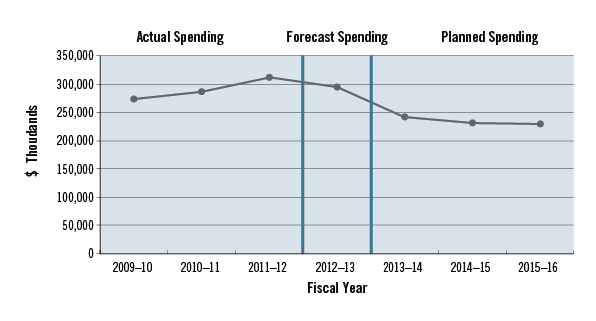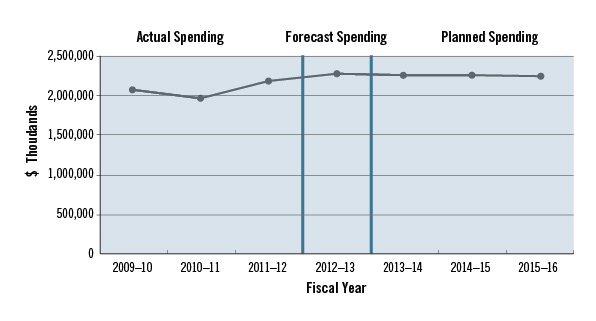Common menu bar links
Breadcrumb Trail
Institutional links
Expenditure Management
Reports on Plans and Priorities
2013-14
Organizational Overview
Analysis of Programs by Strategic Outcome
Supplementary Information
Other Items of Interest
ARCHIVED - Treasury Board of Canada Secretariat - 2013–14 Report on Plans and Priorities
 This page has been archived.
This page has been archived.
Archived Content
Information identified as archived on the Web is for reference, research or recordkeeping purposes. It has not been altered or updated after the date of archiving. Web pages that are archived on the Web are not subject to the Government of Canada Web Standards. As per the Communications Policy of the Government of Canada, you can request alternate formats on the "Contact Us" page.
Organizational Overview
Expenditure Profile
For fiscal year 2013–14, the Secretariat's total planned spending is $5.66 billion. This includes $3.1 billion in centrally managed funds used to supplement other appropriations. The balance, $2.51 billion, is mostly related to Program 5: Government-Wide Funds and Public Service Employer Payments for the Treasury Board's role as employer of the core public administration ($2.27 billion). These funds are used for the following:
- The public service pension, benefits, and insurance, including payment of the employer's share of health, income maintenance, and life insurance premiums;
- Payments to, or in respect of, provincial health insurance;
- Payments of provincial payroll taxes and Québec sales tax on insurance premiums; and
- The return to certain employees of their share of the employment insurance premium reduction.
The remaining amount ($0.24 billion) is directly related to the operations of the Secretariat and its five other programs: Management Frameworks, People Management, Expenditure Management, Financial Management and Internal Services.
Figure 1: 2013–14 Planned Spending Total $5.66 billion

Figure 1: 2013–14 Planned Spending Total $5.66 billion - Text version
Departmental Spending Trend
The figure below illustrates the Secretariat's financial trend from 2009–10 to 2015–16 for the operations of the Secretariat and the following five programs: Management Frameworks, People Management, Expenditure Management, Financial Management and Internal Services. These operations reflect the people and activities that support the Secretariat's strategic outcome of ensuring that government is well managed and accountable and that resources are allocated to achieve results.
Figure 2: Spending Trend for Program Expenditures See Spending Trend for Program Expenditures note * (Vote 1)

Return to Spending Trend for Program Expenditures note * Includes Employee Benefit Plan amounts
Figure 2: Spending Trend for Program Expenditures (Vote 1) - Text version
The Secretariat's actual spending increased from 2010–11 to 2011–12 by approximately $26.2 million, largely due to increases related to the following one-time expenditures:
- Disbursement of severance cash-outs by employees, pursuant to collective agreements that eliminated future severance pay accumulation; and
- Professional services costs for external experts to support the review of departmental spending across government.
These increases were offset by reductions, largely due to the following:
- 2010 Strategic Review decisions;
- A transfer to Shared Services Canada;
- Cost-containment measures announced in previous federal budgets; and
- The ending of funding related to time-limited initiatives.
The Secretariat's planned spending will decrease from 2011–12 to 2012–13 by approximately $28.6 million, due to the reductions mentioned above and to Budget 2012 cost-containment measures. This decrease is partially offset by increased funding for litigation management for Charter challenges and initiatives related to workplace operations.
The Secretariat's planned spending will decrease between 2012–13 and 2015–16 by approximately $53.6 million due to the implementation of the Strategic Review and cost-containment measures mentioned above, the ending of time-limited initiatives, and a transfer to Public Works and Government Services Canada for the Pay Consolidation Project.
Expenditure Restraint Measures
As mentioned above, the Secretariat's spending has been reduced by various expenditure restraint measures. Specifically, the 2010 Strategic Review will provide $11.5 million in ongoing savings by 2013–14. The Budget 2012 cost-containment measures have resulted in savings of $7.6 million in 2012–13, and savings will increase to $15.1 million in 2013–14 and to $23.6 million of cumulative ongoing savings (including 178 positions) by 2014–15. In addition, a total of $10.6 million (including 45 positions) has been provided to Shared Services Canada as a result of responsibilities transferred to the new organization. Over the past few years, measures to increase operational efficiency have also been undertaken to position the Secretariat to operate within reduced resource levels.
Figure 3: Spending Trend for Public Service Insurance (Vote 20)

Figure 3: Spending Trend for Public Service Insurance (Vote 20) - Text version
The amounts presented in the preceding graph relate to the public service employer payments, which include the payment of the employer's share of contributions required under the various insurance plans sponsored by the Government of Canada.
After an adjustment for a reversal of charges for 2009–10 of approximately $62 million, See footnote [2] the net public service employer payments decreased by approximately $38 million from 2009–10 to 2010–11, largely due to the premium holidays under Disability Insurance and a reduction in payments for provincial payroll taxes.
Public service employer payments increased by approximately $224 million from 2010–11 to 2011–12 as a result of a one-time lump sum payment for improvement of long-term disability benefits provided under the Service Income Security Insurance Plan (SISIP) for Regular Forces and Primary Reserve Forces and increased costs for the Public Service Health Care Plan (PSHCP), the Public Service Dental Care Plan, the Pensioners' Dental Services Plan, Disability Insurance and payroll taxes. These increases were offset by the transfer of the costs related to management of pension, insurance and social security programs for locally engaged staff from the Secretariat to Foreign Affairs and International Trade Canada and to National Defence.
Based on approved authorities, planned spending for 2012–13 is $84 million higher than actual 2011–12 spending. However, the latest forecasts for 2012–13 for public service insurance show a decrease from 2011–12 actual expenditures of $64 million. This is mainly due to a non-recurring payment under the SISIP and is offset by projected expenditures under various group insurance and benefit plans. Although planned spending, which is based upon approved authorities from 2013–14 to 2015–16, is relatively stable, it is premature to draw trend conclusions at this time.
Estimates by Vote
For information on our organizational appropriations, please see the 2013–14 Main Estimates publication.
